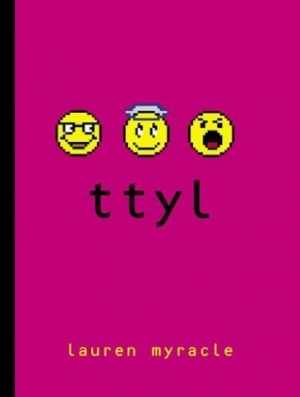Creative Texting: Writing and Textspeak
Though the trend may have faded now, not long ago adaptations of the classics into “textspeak” seemed to be all the rage. These works were full of slang, abbreviations, unique spellings, and unconventional grammar. Not surprisingly, these adaptations sparked intense reactions, in particular for the adaptations of the works of the bard in OMG Shakespeare. But were these works, and others like 2014’s Emoji Dick and Lauren Myracle’s 2004 TTYL, worth all the grief? The critics do have some fair points. Perhaps they were gimmicky and short-lived. It is unlikely original works written in textspeak will go on to become classics or the textspeak adaptations hailed as the new greatest translation. But this doesn’t necessarily make them awful.
If one can ignore their initial offense at this “assault” on writing and literature, the exploration can begin. See these adaptations less like masterful compositions and art installations and more like skillful but uninspired portraits painted from a reference. Not the most intellectual, but still worth examining. They are a show of the author’s skill with words, even if they ask nothing more of the reader than to experience the novelty of them. The original novels are the outsider art of their day. They too contain deep and valuable lessons, if one is willing to look past the packaging.
Textspeak Takes Work
There is a belief that because textspeak is used primarily by youth, it is not as sophisticated as formal English. There is also a more insidious process known by linguists as iconization. In it “characteristics of a language are seen as an iconic reflection of essential characteristics of its users.” 1 Essentially, because viewers believe textspeak is lazy writing and less sophisticated, textspeak users, including authors, must be lazy and unsophisticated writers.
Not only is this unfair to those who use textspeak, it is inherently untrue. Linguists have had the debate, and it is already decided that using textspeak does not make one less able to use formal English. So writers using textspeak as parts or even all of their work are not trying to make up for a lack of language skill. In fact, they may have a better grasp of the language then some. Linguist David Crystal asserts that, “Before you can write and play with abbreviated forms, you need to have a sense of how the sounds of your language relate to the letters.” 2 Essentially, just as the poet is aware of the syllables, sounds, and breaks in words to evoke a feeling so the textspeaker must know how far they can go in abbreviations, changing spellings, and new punctuation and still be understood. This is doubly true for authors who are trying to use textspeak to evoke emotion, be understood and carry plot and character.

Consider, too, the amount of work that goes into even automatic writing. When one writes in a stream of consciousness style they are uniquely present in their words, and though they may not choose what to write on, they are still, in some way, choosing how to say it. There is a self-awareness and focus in all kinds of writing that requires the writer to decide, always, what they put down. This is true for textspeak or for formal English. The writer is making decisions, always, about which word to use, and which spelling, and even where to add the extra exclamation marks.
In even more modern adaptations the simple emoticon has been replaced with the increasing number of emojis that can represent any number of things. As in the case of Emoji Dick, these tiny images can (almost) be used to carry an entire story on their own, like pictographs. Pulling complex meaning out of these icons is a challenge for both writer and reader. Oftentimes, emoji aren’t used to craft whole sentences, simply because it isn’t that easy, and that wasn’t what they were designed for. They just aren’t layered enough for that sort of translation. Works like Emoji Dick often have to make great stretches and leaps to make it work. (Linguist Gretchen McCulloch’s blog post is an excellent further discussion on this phenomena).
Combined with textspeak and other alphabetic text, though, emojis can add delicious depth to a written work that asks the reader to work a little harder. That work, in itself, goes against the traditional notion that textspeak is a shortcut for the lazy writer. This, along with the image response found online (though less often in creative writing usage of textspeak) is “at first glance quick, simple, and clear, with the user’s emotional reaction plainly comprehensible.” But, if one attempts to use textspeak, emoji, and image response for an extended work they will know “that the process required to use them is fairly laborious.” 3 How can something that requires such dedicated focus, concentration, and decision-making be lazy, and automatically flawed?
Traditions
Perhaps part of the problem is that translation time. Readers don’t always want to spend minutes on one line, deciphering the meaning behind an emoji. This is fair. However, textspeak’s opponents suggest that because the reader must go to such work to translate a work from textspeak to something they can understand it is inherently flawed. Writer for the Daily Mail John Humphrys says that, “If the recipient of the message has to spend ten minutes trying to translate it” textspeak stops being useful and, “instead of aiding communication..can be a barrier.” 4 However, one could argue that the act of translating textspeak, at least in the case of the non-urgent creative writing usage can increase one’s involvement with the work or even the fun found in it. Additionally, the work of translation can elevate simple work to the level of poetry. Finding the meaning beneath the meaning in textspeak can work the same as explication.
On the note of poetry, there is a rich history in that tradition of changing punctuation, line breaks, and word shortening. The work of e. e. cummings is a perfect example of a writer playing with punctuation, capitalization, and spelling of words to further a work’s overall meaning. His choices were deliberate. Today they are praised for their revolutionary quality, and emulated by other poets. What is to say that textspeak is not just another step in this tradition?

The abbreviation and word shortening in textspeak has a history and a tradition as well. Medieval manuscripts, written in both Old English and Latin, were rife with shortenings and abbreviations. This was most often to save time and save the effort of writing out many, many long and complicated characters. This also carries an extra lesson to those who consider Shakespeare and other classics “too important” for textspeak. To the writers (and abbreviators) of medieval manuscripts ,“Even the Scriptures were not considered too sacred to abbreviate.” 5 All work, and all words, are open for re-interpretation.
A Voice With Personality
Assuming one has pushed aside their former beliefs about textspeak, and accepted that the writers who chose to use it make conscious, creative choices, one can examine the uses for textspeak in a creative work. Textspeak has two main benefits; allowing one to better convey their feelings, and allowing one to better represent themselves. For the creative writer, this allows for a stronger conveyance of voice, and to help present character and personality in new ways.
The idea of “textual paralanguage” can describe a majority of the ways that textspeak conveys emotion. Paralanguage is traditionally associated with speech and makes up all the parts of communication that aren’t the words themselves such as tone, body language, and pitch. The Idea Channel presents this concept in their discussion of emoji, and explains that emoji can be thought of as a type of gesture, aside from all their other uses. We see what the speaker means as well as “hearing” it. 6
In this way, textspeak transforms simple, plain English into a sort of performance. The reader hears the voice of the writer, whether that be a professional author playing a character or their friend telling the reader about their day. This is not unlike script writing, which includes stage directions and cues for tone. Though, it is also intersting to note that textspeak is an inherently visual form, and though one will receive textual paralanguage in the process of reading, how would one read aloud textspeak? Is there a universally accepted pronunciation of “lol”? How do you pronounce the face with tears of joy emoji? It can’t be done, at least not yet. Not without adding extra words the textspeak or emoji was designed to replace. But this is one of the delicate intricacies that textspeak demands. It is part of what makes it a complex language form worth using.
Aside from adding facial expression and gesture, textual paralanguage can be found in other places, such as specific punctuation, like excessive exclamation points. This conveys more excitement than a simple period or even one exclamation mark. Using “u” instead of “you” is no longer just to save time, but more in accordance with the formal/informal style of address of the romance languages. Capitalizing some of the words but not others adds emphasis, or changes the tone to excitement or anger. Multiple messages and line breaks, as in poetry, have taken some of the weight of the period. (Here are a few examples of various ways we say, “yes”, how the period has changed its tone, the usage of “u” versus “you”, and why we add extra letters to words.)
A highly trained writer who wishes to use textspeak can take advantage of this fact in their fiction. In moments (or messages) full of tension or excitement more capitalization or exclamation marks could be used. Ellipses could show up more when a character is skeptical, suspicious, or even hesitant. If emojis were available or desired, these could be used to add a whole new layer of feeling. The message “cool” will come across differently than “Cool!” with a few sparkle emojis afterward.
Overall, paralanguage is a complex intuitive system individual to the user. It is so individual that in some cases, this can even be used as evidence in crimes. In 2002 “a detailed comparison of the vocabulary and other stylistic features of…text messages,” discredited a man’s alibi and helped find him guilty of murder. 7 Obviously, no two textspeakers are exactly alike, and some may not even use the same tone with the same individuals. This is a sign that textspeak’s intuitive system of presenting one’s emotions and voice sits easily beside one’s ability to present themselves in whatever way they please.

In the case of emojis, there was once limitation to how one could represent themselves, or how a character could describe themselves, simply by the nature of skin tone. 8 Until more diversity was introduced, it would have been harder for a character to identify as darker skinned and still use emojis such as the hand or even the simple boy or girl emoji to identify. This has been solved, thankfully, thus allowing writers access to a wider range of characters and human experiences, and aiding in the struggle to increase diversity in creative writing.
This extends beyond emojis alone. Even the basics of writing and orthography can be part of one’s identity. For one user in a study, “his writing style (is) an inherent part of his identity,” and he chose to misspell or play with grammar to remain connected to a culture. 9 Criticism of his writing thus become an attack on or misunderstanding of that culture. It is similar to how those involved in a trade use the technical jargon and terminology of their trade when talking with one another. They know they will be understood by that specific audience, and so speak freely. Textspeakers who communicate together know that their choices will be understood, and so they are free to write in the way that is not only the most comfortable, but the most accurate to who they wish to be.
This is a little more difficult for the creative writer, as they have the ultimate goal of being understood by a reader and telling a story, but there is still room for play as well. Characters who are softer spoken could use less capitalization or fewer words in general. A character could choose not to use textspeak, for whatever reason, and this, too, would show their personality or their lack of identification with internet or textspeak culture. Specific abbreviations or slang words, like those in gaming culture or found on a specific social media site like Tumblr, could be used to show a character’s connection to that culture. An inexperienced reader may not pick up on all of these subtleties, but a skilled writer will be able to draw enough personality from other sources, even ones as simple as word choice, that the character should still shine through. Even if it proves more difficult, when writers do choose to include mediums like text messaging or IM that would normally contain textspeak, it is in their best interest to take advantage of this medium, and pay as much attention to their textspeak writing as their formal English.

Only time can tell how textspeak will step into modern communication. As writing in the voices of youth continue to grow in popularity, writers will need to pay closer attention to their textspeak. In the YA genre, in particular, it is nearly essential to have some understanding of the linguistics behind textspeak to capture the teenaged voice authentically. The text has spread as a mean of communication beyond just the young, though, and even the most stoic adult send texts—a few with minimal textspeak included. Ignoring the opportunities presented in textspeak is ignoring a tool ready and waiting for the writer.
To demonize language change is to fight a futile fight. The change is already here. Embracing it, riding the wave, and using it all to the advantage of creative writing now is worth more than chasing the status of a classic. Because the people of the present don’t get to decide what gets remembered. That’s the job of the youth of tomorrow, and if texting trends tell us anything, they’d probably like a few more sparkle emojis in their life.
Works Cited
- Bogetić, Ksenija. “Metalinguistic Comments In Teenage Personal Blogs: Bringing Youth Voices To Studies Of Youth, Language And Technology.” Text & Talk 36.3 (2016): 245-268. Academic Search Complete. Web. ↩
- Crystal, David. “2b or Not 2b: David Crystal on Why Texting Is Good for Language.” The Guardian. Guardian News and Media, 04 July 2008. Web. ↩
- Grant, Harley. “Tumblinguistics: Innovation and Variation in New Forms of Written CMC.” Diss. Academia.edu. Web. ↩
- Humphrys, John. “I H8 Txt Msgs: How Texting Is Wrecking Our Language.” Daily Mail Online. Associated Newspapers, 24 Sept. 2007. Web. ↩
- McNabb, Cameron Hunt. “The Truth about Internet Slang: It Goes Way Back.” Salon. Salon Media Group, Inc., 3 Aug. 2014. Web. ↩
- Can You Speak Emoji? By Mike Rugnetta. Perf. Mike Rugnetta. PBS Idea Channel. Public Broadcasting Service, 13 Apr. 2016. Web. ↩
- Crystal, David. “2b or Not 2b: David Crystal on Why Texting Is Good for Language.” The Guardian. Guardian News and Media, 04 July 2008. Web. ↩
- Can You Speak Emoji? By Mike Rugnetta. Perf. Mike Rugnetta. PBS Idea Channel. Public Broadcasting Service, 13 Apr. 2016. Web. ↩
- Bogetić, Ksenija. “Metalinguistic Comments In Teenage Personal Blogs: Bringing Youth Voices To Studies Of Youth, Language And Technology.” Text & Talk 36.3 (2016): 245-268. Academic Search Complete. Web. ↩
What do you think? Leave a comment.











This is a great in-depth analysis, but I just can’t get past the first requirement to enjoying it…. I can’t make myself give credit to text-speak as something worthy of respect… Perhaps I can with regards to comedy, but as a legitimate writing style? It does open doors, but these shouldn’t necessarily be opened. It’s just too—odd, for me to see one friend text about a hardship and another reply with a ‘crying emoji.’ It feels sanitized and kind of gross? I…ugh…I don’t know how to feel about text-speak. It really ticks me off, but not in a pretentious/disgusted way. Tangentially: to whomever says emojis are opening doors to new self-expression, factor in that there is a finite amount of them, and typically the same 20 or so are used. Like, when 15 people send you a heart, it’s more of a limit on expression and individuality (one might argue that text-speak, drive by conventions, is similarly limiting). This all coming from the person who responds to 15% of anything with ‘RIP,’ so grain of salt, I guess…
Thank you for reading, and trying, at least to understand. That is much appreciated. I understand where emoji and the like can become unifying or sanitizing. However, from a writing perspective, understanding the character and understanding how people tend to communicate, can limit that kind of “crying emoji only” response. Textspeak is more than emojis and shortening words. It’s also about knowing how to convey your tone. Thinking about my own textspeak conversations, people switch easily between formal tone and informal. Comforting someone isn’t usually the time to use the informal. I do agree though, the works we have now using textspeak and emoji are not using it the most masterful effect, and are relying a lot on the “crying emoji=sad” equation without much consideration for how people truly communicate. Thanks again for your thoughts!
Publishers who thrive on the intricacies of language should know better than to mock its developments by giving the impression that teenagers are so engrossed in technology (as goes the popular narrative amongst adults) that we need to be baby-walked through literature to sustain our attention.
This is a very good point! I hadn’t thought of this in these terms, but as I said, I doubt adaptations written in textspeak will ever be heralded as good. I try and think of it in terms of “experiments” (which didn’t work well in this case). Works like Emoji Dick, and perhaps even OMG Shakespeare, were done because it was possible. But due to the limitations of emoji it didn’t really work. Perhaps this is a sign that original works incorporating textspeak should be the new direction for using textspeak in publishing.
Codify a language and you strangle it; diversity and inventiveness is the beauty and evolutionary engine of language; if it fulfills it’s purpose of conveying meaning to the intended recipient, then all is well.
Exactly how I feel about the thing! It’s all a matter of considering audience or recipient.
Unfortunately I think txtspk is the opposite of diversification. In everyday use it shrinks the language down to a handful of over-used abbreviated phrases that can only convey an approximation of what the writer is feeling/thinking. It encourages people to write in a boring, generic way.
Personally I’m not bothered if people want to use it in text messages, as they are a pain to write and limited in length. But when people use the same stuff in emails it’s just rubbish. It always feels like the subtext is “I can’t really be arsed to write this message or to think about what I want to say”.
That is a very good point. Maybe that’s why textspeak has grown to include variations in punctuation and emojis together to better convey emotion!
As for your comment about e-mail,I would agree, in most cases. But that is because, an e-mail is not the usual expected place for textspeak, unless of course I were e-mailing someone who would expect it from me. Using it in an e-mail to a co-worker would be unexpected and therefore less acceptable. E-mailing a friend partner in the middle of the day would be a more suitable place for it.
Personally, I wouldn’t agree that textspeak encourages writing in a boring, generic way. I feel like the shortened words and phrases generally only get used in cases where the full phrase would’ve been used anyway. Furthermore, the creative use of emojis helps to attempt to fill in the blank where emotions, facial expressions, body language, and tone of voice doesn’t get transmitted over the phone. Using language that is too formal with peers while texting can be more strange because it suggests some seriousness or awkwardness for which the receiver has no explanation.
Perhaps your experiences with people using textspeak have been different from mine.
I do believe that there are appropriate and inappropriate uses for textspeak. If something is important enough that I’m not texting on my phone, then it’s important enough for me to check my grammar and look over what I’ve written. Furthermore, I do not use textspeak often when texting people who don’t seem to use it themselves; there’s no guarantee they would understand it.
You often see language tends adapt toward changes that could condense the meanings and words to profit for less effort in conveying messages, which is something that has sort of been accessory for “improving” languages. I think when you have mediums that permit the sort of short, condensed language it is hard to ignore its usefulness, but you make the exact point that it doesn’t accomplish the exact meaning. We as humans are used to being able to breathe life through language, and it is because our meanings can be misunderstood that any language has such an elaborate structure, since we give ourselves an immense variety of words and tools to accomplish that purpose. Codifying is something that I’ve never thought of when describing the way people try to force this kind of medium, and it fits perfectly.
Your conclusion is one of the best I have ever read! Great comment on the future and very insightful. A good ending to an interesting read on a relevant topic. Our language is changing and as we try to communicate across the globe, I wonder if texting will become even more prevalent.
I don’t think I have been this bamboozled by an article ever. An amazing read, now I have to ice the headache and decide what my take is on the subject.
Agreed. Great article and well-written and nicely pieced together. Purists will scoff at textspeak and criticize it for bastardizing the language, whereas linguists will recognize the evolution of technology and how language evolves with it. Textspeak is a perfect example of this evolution. Whether you like it, use it, demonize it or whatever, it’s a part of a natural change in how we communicate. I tend to be more on the purist side and go to great lengths to text out my “you” and not “u”. I just can’t bring myself to do it … Oh, I do write “lol” and/or “hahaha” — whichever is cooler nowadays.
Probably correct saying it started with the Internet, but many early SMS users developed txt independently of IRC etc, and with only 160 characters to play with costing money (it seemed so costly yet amazing at the same time!), the human brain got inventive about communicating.
I’d rather see gd txt than bad spelling or grammar any day.
Personally I use abbreviations when im typing on a phone because of the amount of button pushes necessary to get to letters. Isnt this the reason most people do it?
Any and all communication is good. Normally I prefer to write properly, use apostrophes correctly, but from time to time abbreviation is appropriate.
I have nothing against ‘txt talk’ as long as it’s comprehensible and contained entirely WITHIN text messages. It irritates me when someone types it out on the internet, as if the sender absolutely needed the miliseconds they saved by not pressing the keys with vowels on; or when a person actually says “LOL” out loud (even if it’s ironic), or pronounces the letters of OMG.
Text speak arose out of the early numerical keypads with multiple letters per button. It will disappear as voice recognition becomes more common
Anyone who texts like this should have their phone confiscated until an acceptable standard in legibility is learned.
Perhaps if they were texting you they might change their legibility, but does it really matter if they were texting someone who might understand them? “Standard legibility” is always changing, even in formal writing. John Humphrys (who despises texting) mentions in his piece that he’s had to adapt to changing rules involving hyphenated words. Would you feel so strongly if someone were not following those new hyphen related, and other rules?
I do agree, though, that if one were a creative writer trying to incorporate textspeak into a piece to be read by a large audience they would certainly have to contend with the familiarity of their audience with the textspeak they were trying to use. Thank you for reminding us, as writers, to always keep our audience and readers in mind.
Very excited about this article, happy to say I learned a few things. I do appreciate the comparison of emoji writing to pictographs, which reminded me of the cave paintings. Then I started thinking about the universality of emoji’s; the ability to bring people together who have different languages and cultures. For the most part we can communicate with each other via visuals because they can evoke a human condition. I also agree with you that yes, this evolving paralanguage will be the accepted means of communication in the near future; as those who were exposed to it at an early age will be the new leaders. I also find the new use of the period me concise and vibrant. Thank you. Yay!
This topic is interesting because it is relevant to the type of way we all communicate on the daily basis. I find textspeak a convenient way of communicating at a faster pace. Using abbreviated words and phrases helps save time when texting long messages, and it helps when you need to text in emergencies while at work or school. I dont think it should be used if your writing a paper or for professional reasons. The emoji is a great feature now it helps me express my feelings better than words. If like painting a picture of 100 words fast and easy. Sometimes it helps express emotion better than words, society is changing everyday and this helps add to our change in communication.
I’m all for making things clearer for readers to understand when necessary, but it is not okay for us to dumb down the minds of young people.
But is this type of writing really “dumbing down” the minds of young people? What Mariel argues is that textspeak actually involves a rather complex process. Sure, textspeak is sometimes used as a shortcut and misses that process, but not in all cases.
Isn’t is about getting your thoughts or ideas down as quickly as possible? I type as fast as I think, so if I’m txt wrtng I’m thnkng fstr than normal! Maybe.
Exactly right; and that is exactly the problem. Perhaps it is not always a good thing to ‘get your thoughts or ideas down as quickly as possible’. Perhaps it is better to think slowly and communicate slowly. Many of the great modern prose stylists often consciously and deliberately practised slow writing and promoted slow reading: Conrad, Nietzsche, Joyce.
The trouble with your argument, HitMan, is that meaning is utterly tied into the means of expression. It is very common for people like yourself to give the pat answer, ‘Language is always changing’. This is indisputable, but it does not follow that it is always changing for the better! The fact is that txtspk has done nothing to expand or develop meanings, but has only reduced and straitened the English language (and, I assume, other languages). The danger is that members of the rising generation, for whom txtspk is not only a way of life but also encouraged in them by rubbishy exhibitions like the one described above, may lose the ability to think because they will never have developed powers of higher verbal expression.
It is common to cite Orwell in such cases, and for good reason. Newspeak was certainly an example of how ‘language always changes’, but was also a central part of Ingsoc’s campaign to reduce the ability of its subjects to express themselves in any personal or unique ways.
HitMan, utilitarian speed is poor recompense for loss of linguistic expression. If your messages are so watery and insubstantial as not to require any form of higher expression whatsoever, perhaps one ought to consider whether it is worth sending such messages in the first place.
Most linguists seem to agree that the use of textspeak and diverse language actually demonstrates a complex understanding of language. Young people have to have “developed powers of higher verbal expression” in order to properly use textspeak. As I quoted in this article, David Crystal (a linguist) states that in order to use textspeak one must know how far they can break the language down and still be understood. You can’t know what “tht” means unless you can fill in the missing vowels, and know that a recipient will “hear” the missing letter because of how we read and speak consonant sounds. You can’t use abbreviations like “omg” unless you can fill in the missing words, and understand the tone conveyed as well. This is echoed by John McWhorter, Derek Dennis, and Sali A. Tagliamonte (all linguists) among many others.
I agree that perhaps the text message or other textspeak forms isn’t the best way to convey one’s most complex ideas, but it isn’t the cheap, simplified mode of communication some may see it as. It is just another, newer form that should be taken for what it is, without initial judgment.
All my students crack up if I say OMG WTF in class once a semester as ironic comment. And using the WTF is actually more palatable than the actual words to a bunch of 19 yr olds, and probably to the administrators. Oops, sorry, I meant 19 year olds.
Text speak is spreading to all generations my grandparents use text speak. my grandmother thought LOL meant lots of love. My grandfather tries to text talk but than after he says something asks me what did he just say. i think it is the most funniest thing ever that text talk is now evolving and is not just a young thing. However text talk is a bad habit when I’m trying to write my papers.
Hmm….nice read
I recall showing my wife SMS (as it was then called) sometime in the early 90s. I built a simple email->SMS gateway for a holiday in France in 1994 and recall with great excitement being able to read my mail by stopping the car in the layby near the house which had GSM coverage. She convinved me that both technologies would be to marginal interest to geeks: after all, SMS wasn’t originally planned as a customer-facing service, and email was clearly not ready for the mainstream.
Ironically, having played with texts then, I use them rarely today. But when I do, in common I believe with about 99% of the userbase, I use a phone with predictive text. Not merely does it do a good job of the words, but when I want for some reason to mis-spell a word, or use a word it doesn’t know, I have to jump through hoops — I affect spelling my name in all lower case and it still thinks it knows better.
So why are people still writing these silly contractions, when their phone will do the job better, faster and with fewer keystrokes?
In my research and personal experience abbreviations have actually taken on a new form to convey voice and emotion! Predictive text and the like has changed their usage from saving time to being a deliberate choice. When answering a text from my friend who’s just told me a new song from an artist we both like has come out I might answer “omg!” or something similar to help my friend see, and “hear” my reaction and excitment. If the same friend were telling me about a particularly irritating person in their class I might respond with the full written “oh my god” to convey my mutual annoyance. For more information I would check out the links embedded in the article going out to the articles “How to say “Yes” without saying “Yes” and “What’s the Difference Between ‘you’ and ‘u'” for some more reading if you’re still curious. Sali Tagliamonte also has a good study of this kind of thing called “Linguistic Ruin? LOL!”
Using over-complicated language is bad writing; “textspeak”, while useful for texts, is bad spelling.
It’s a text, though, not a cover letter for a job application. “Bad spelling” is defined by the context.
Textspeak isn’t necessarily done for speed or out of laziness, but simply because of the limitation of an SMS message to 128 characters. Like early computer programming, it’s the limitations of the technology that dictate the form. I have a (touch-screen) qwerty keyboard on my mobile, but I still abbeviate if I have a longish message to send. C wot I mean?
I am so grateful for your article.Really thank you! Really Cool.
What’s the difference between a text message (160 characters) and a haiku (14? syllables and some other obscure rules)?
That’s exactly my feeling! Although most texts are free from the character limit, people still tend to limit their word usage or change their form of expression to convey their feelings, similar to haiku. Thanks for bringing this up!
When I was a schoolboy, we had an English teacher who said ‘erb and ‘ospital (I can’t remember in what context those words came out). It was certainly considered good style in some posh parts of society, though I’m not sure why.
Universal education has produced “spelling pronunciations” that are now standard and perhaps the loss of the old version is regrettable. Of the old ones, I like “weskit” for “waistcoat” and “lanskip” for “landscape”. Maybe others are only just clinging on. I wonder how many young people say “tuppence”. I suspect most say “two pee”.
txt spk comes from the restrictions on character numbers in texts, not speed of writing and/or comprehension. And if you don’t like it then please go learn Latin, coz English ain’t ever going to be your cup of tea is it?
Linguistic creativity ftw. Down with proscriptivism! lolz!!!!eleven!1! XP
I think that some way of communicating the fact that what someone said actually made you laugh out loud is necessary in this kind of communication (instant messaging) which is often very fast and sometimes very funny… And its nice if you are in a situation where you make a comment and people around the (cyber)world laugh But I personally use “haha” or “ha”.
I agree with most replies here that bring up the point of textspeak’s origin. This weird way of communicating arose due to the fact that old phone models had that traditional number keyboard so it became easier 2 write lyk dis
Whenever people talk about x destroying English I usually say that I think that English is a monster that is pretty much alive and out of our hands now and in most cases, such as this one, its expanding to fill a new environment..
Very good. Thank you.
Textspeak is indeed a hard genre to master. It’s very easy to fall into a pattern of how you ‘think’ the youth texts versus how they actually do.
Thanks great. I love emoji’s haha. 🙂
What a fantastic, thought-provoking article. I teach a college-level dance critique and writing class that falls directly into this argument. Like successful modern dance, the technique and tools are the keys to the form. If a writer is playing with textspeak with a clear understanding of conventional language it’s just another artistic expression. Let’s keep fighting the good fight to keep people thinking about the hows and whys of our evolving language and art. This is a great place to begin.
Textspeak is essentially a new language. Simplistic yet with its own ever-fluxuating rules and boundaries as any developing language. As a language however, it is unique in that it will evolve with contemporary technology – the first of its kind. And who knows how many more there may be?
This is a really thought-provoking article and the discussion around how people express their identity through text speak was particularly interesting. I find that text speak is used to express group membership with at least one other person- Using a specific text dialogue either includes or excludes a person. For me personally, I find that when texting different people, my use of text speak changes in order to fit in with each crowd. Text speak provides a way for people to express themselves in an everyday manner without effort, which is important for young people especially.
Interesting read.
If books in this format encourages a wider reading public, its “literary standard” shouldn’t be of critical importance. If it encourages readers to pick up classics they normally wouldn’t, and if they gain something out of the story, why not publish more?
We are in the early days of this language revolution – the intensity of feeling and thinking of the pro and con groups is indicative of this. We are living through a wondrous moment of language evolution – and I relish it, even though I wonder where it is taking usall! Enjoyed reading this thoughtful document – thank you.
I think texting is a very interesting form of slang. It’s basically like old English; one day it’s going to become obsolete, and the average person will need to take a class in order to decipher what it means, and scholars will pour over texts written in “text speak” in an attempt to translate it into modern language. Language is such an interesting topic! I love learning about how it changes and morphs over time!
An insightful analysis… I find that, sometimes, emojis convey more meaning than words. At the end of the day, isn’t that the point of language?
It’s refreshing to read an article that defends textspeak and the use of emojis, though I thought there were a couple of missed opportunities. I haven’t read all the other comments so i’m not sure if anything I have to offer has already been said, so if i’m repeating anything I apologize.
I thought the article might have benefited from a stronger background in sociolinguistics, as there were some excellent points which could have been expanded upon to strengthen the article. Linguistic shift is one example, and how sociolects impact linguistic shift. Internet-based sociolects entered common use over a decade ago, but are still thought of as being extremely new because they evolve far, far more quickly than non-internet-based sociolects. Yet this also makes them easier to study from the perspective of corpus linguistics.
That aside, I enjoyed reading this. Thank you for sharing 🙂
I think the underlying issue here is defining and separating concepts of value and standards.
No one would think that textspeak should be the defining standard for American English spelling, although some short-sighted individuals might use it as such. It has value in its convenience and social usage. An actual language standard remains, however, and should be recognized as such in order to promote societal communication that bridges decades and generations. That standard communication is essential to maintaining the progress we have made in the last 500 years, and should not be changed easily.
Freedom of expression and the appreciation of social diversity are so important, but not at the expense of being able to talk to one another at all.
Cool article. There are certain things about textspeak and “text” writing that will always drive me nuts, like trying to decipher whole sentences made of emojis (I don’t know whose brilliant idea *that* was). But with that said, I can (somewhat grudgingly) admit that text writing is carving a good niche in the creative writing/literary world. Being a member of the Grammar Police and lover of correctly spelled words, it pains me to say so. But then again, I guess it’s like CliffNotes and Sparknotes. Just because those methods of understanding literature exists, does not mean the value of literature goes away. If the books themselves aren’t threatened, why should we as readers be? (Well, books are inanimate objects, but I hope you know what I’m getting at here).
Interesting…
However, I’ve recently read an article in which discussed Textspeak in correlation to communications in relationships.
With the light of both of these articles, its difficult to say which I’d prefer. Personally, I fall victim to Textspeak… I fully incorporate the use of emojis and short form terms while texting. But is this a habit I wish to rid?
This is an interesting defense of textspeak, and the crux of it for me is the idea that criticising the linguistic choices of a writer carries connotations of criticising their culture, though I think that defense rests on the assumption that the writer has made active choices about the language they use. I get frustrated when people defer to emojis or textspeak because using their own voice is too difficult, and I think it’s reasonable to criticise a culture that encourages such sloppiness. But I’m all for using textspeak in creative ways like Emoji Dick.
This article is fascinating to me, as someone who upon first entering the digital world hated the very thought of using textspeak in any scenario. I have now come to realize many of the things presented within this article, and I would completely agree with the idea that textspeak is almost a separate dialect of written English entirely. It takes skill to be able to interpret this textspeak, and so many people write it off as laziness. It reminds me of the book series Chaos Walking by Patrick Ness, where the books are written linguistically according to the point of view of the narrator. For the main character Todd, it’s written using poor grammar and spelling, as though the uneducated boy himself was writing it, whereas with female lead Viola, with a better education, the language is more clear, with the two coming closer together as they each change each other throughout the series. It’s amazing what using these intricacies of language can do to a story or even just a daily conversation.
I like how detailed you got into for something that may initially seem so minute, like the emoji you find on your phone keyboard everyday. It provides insight to the intricacies of our languages and how ever-changing it is.
I’m the first to admit that I find text-speak in a novels to be rather cringe worthy. I think, perhaps, because the language we use is changing so quickly nowadays, it doesn’t take long for a phrase to be dated. Case in point, ‘YOLO’ was used incessantly less than 10 years ago, and now its avoided at all costs (at least in my observations). However, perhaps this is something I will grow to like (if not tolerate at the very least).
Good article!